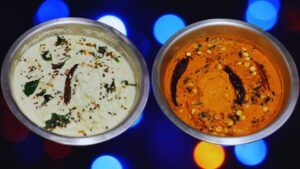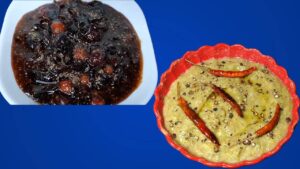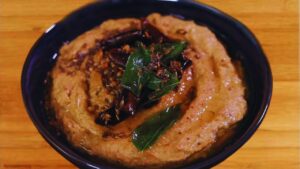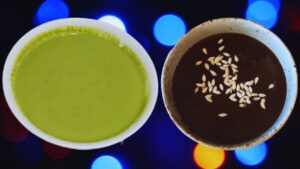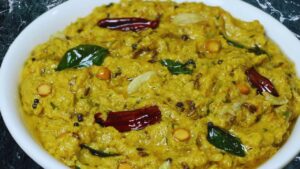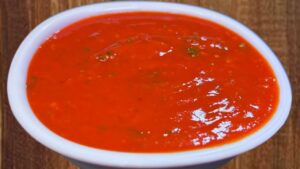Onion chutney comprises onions, lentils, ginger, garlic, and other ingredients. It is also tempered with different spices. Follow my recipe to learn the steps to make onion chutney at home.

KEY TAKEAWAYS
- Onion chutney is a versatile condiment that will enhance your dining experience.
- Store the chutney in an airtight container. Keep it in your fridge.
- Serve this chutney with South Indian dishes, Indian bread, rice dishes, bhaji, fritters, and snack items.
- Store the chutney in an airtight container. Keep it in your fridge.
- Onion chutney typically offers a sweet, tangy, and spicy taste with slightly savory notes.
- Other chutneys such as tomato chutney, coconut chutney, mint chutney, tamarind chutney, and onion-tamarind chutney will closely resemble the taste of pure onion chutney.

I got this recipe from a young beautician during my threading session. While she was busy working on me, we talked about food and cooking and shared our interests and preferences. She said she cooks mainly on Sundays and she likes making chutneys. She uses unique ingredients to make them. She described this particular chutney she always makes for herself.
I noted it mentally and made it that weekend. My husband said it had flair, and the boys liked its “salon twist.” Now, it is our pamper-day platter. That chat reminded me that people who help us look good also enjoy feeding their own joy—with quiet pride, small routines, and meals that sparkle in their own way.
How to Make Onion Chutney? (Step by Step Guide with Images)
Step 1: Take a wide pan or wok and heat it on a low flame on your gas stove. When it is hot enough, put 1 tbsp of white oil in it.

(Pro tip: You can use white oil of any brand).
Step 2: When the oil is hot enough, put 1 tbsp of split chickpeas (chana dal) and 1 tbsp of split black gram lentils (urad dal) in it.

Step 3: Stir the lentils continuously for about 2 to 3 minutes to fry them nicely. Do not burn them and see that the color does not change more than light brown, if at all.

Step 4: At this point, add 4 large pieces of onions, chopped roughly, to it.

Step 5: Sauté the onions for 2 to 3 minutes till they turn translucent and succulent.

Step 6: Now, add 1 piece of fresh ginger of about 1-inch size, roughly chopped, and about 12 small cloves of fresh and deskinned garlic to it and sauté them for a few more seconds.

Step 7: Then add in about 12 pieces of byadagi red chilies and sauté for a few seconds.

(Pro tip: If you do not have byadagi red chilies at home, you can use spicy red chilies or Kashmiri red chilies as their alternative. Make sure that you adjust the quantity of the spicy red chilies according to your preference and the quantity of onions you are using).
Step 8: Then add 1 piece of tamarind of the size of a gooseberry. Make small bits of it and mix it nicely with the ingredients for a nice tanginess to the chutney.

Step 9: Now, add 1.5 tsp rock salt and mix it well with the ingredients.

(Pro tip: If you do not have rock salt at home, you may use regular table salt as its alternative).
Step 10: Once the onions are cooked nicely and turned their color to slightly golden-brown and the other ingredients are no longer raw, turn off the flame of your gas stove.

Step 11: Transfer everything to a plate and set it aside to cool off completely.

Step 12: When the ingredients have cooled down completely, transfer them into a mixer jar.

Step 13: Add 1 tsp of jaggery to the mixer jar.

(Pro tip: If you do not have jaggery at home, you can use brown sugar instead).
Step 14: Grind the ingredients just once without adding any water to it to get a coarse and thick mixture.

Step 15: Now add about 2 tbsp of water to it.

Step 16: Grind everything into a fine paste.

Step 17: Check the color and consistency of the mixture. If needed, add some more water and blend it again.

Step 18: Now, transfer the chutney into a bowl once you get the desired consistency and keep it aside.

Step 19: Now, for the tempering, take 1 tbsp of white oil in a frying pan and heat it.

Step 20: Add 1 tsp of split black gram lentils (urad dal) and 1 tsp of mustard seeds to the pan when the oil is hot enough.

Step 21: Now, add 1 tsp of cumin seeds to it.

Step 22: Once the mustard seeds stop crackling, add 4 red chilies of medium size to it and sauté.

(Pro tip: Be careful of the hot oil sprinkled with the crackling mustard seeds).
Step 23: Now, add ½ tsp of asafetida powder and mix it nicely.

Step 24: Finally, add 10 to 12 pieces of curry leaves and stir them for some time.

Step 25: When the curry leaves are fried nicely, transfer this tempering to the onion chutney in the bowl.

Step 26: Finally, your delicious onion chutney is ready to be served with a variety of snacks and dishes of your choice.

Recipe Card
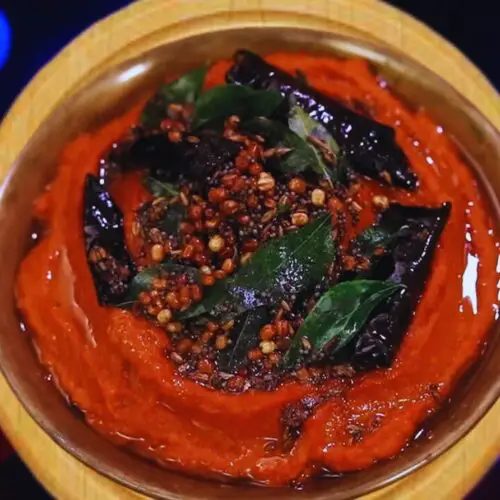
Onion Chutney | Pyaz Ki Chutney
Ingredients
- 4 pieces Onions large size (chopped roughly)
- 1 tbsp White oil
- 1 tbsp Split chickpeas (chana dal)
- 1 tbsp Split black gram lentils (urad dal)
- 1 piece Fresh ginger 1-inch size (roughly chopped)
- 12 cloves Fresh garlic (small and deskinned)
- 12 pieces Byadgi red chilies
- 1 piece Tamarind (small gooseberry-size)
- 1½ tsp Rock salt
- 1 tsp Jaggery
- 2 tbsp Water
For Tempering:
- 1 tbsp White oil
- 1 tsp Split black gram lentils (urad dal)
- 1 tsp Mustard seeds
- 1 tsp Cumin seeds
- 1 pieces Red chilies medium
- ½ tsp Asafetida powder
- 10 pieces Fresh curry leaves
Instructions
- Take a wide pan or wok and heat it on a low flame on your gas stove. When it is hot enough, put 1 tbsp of white oil in it. (Pro tip: You can use white oil of any brand).
- When the oil is hot enough, put 1 tbsp of split chickpeas (chana dal) and 1 tbsp of split black gram lentils (urad dal) in it.
- Stir the lentils continuously for about 2 to 3 minutes to fry them nicely. Do not burn them and see that the color does not change more than light brown, if at all.
- At this point, add 4 large pieces of onions, chopped roughly, to it.
- Sauté the onions for 2 to 3 minutes till they turn translucent and succulent.
- Now, add 1 piece of fresh ginger of about 1-inch size, roughly chopped, and about 12 small cloves of fresh and deskinned garlic to it and sauté them for a few more seconds.
- Then add in about 12 pieces of byadagi red chilies and sauté for a few seconds. (Pro tip: If you do not have byadagi red chilies at home, you can use spicy red chilies or Kashmiri red chilies as their alternative. Make sure that you adjust the quantity of the spicy red chilies according to your preference and the quantity of onions you are using).
- Then add 1 piece of tamarind of the size of a gooseberry. Make small bits of it and mix it nicely with the ingredients for a nice tanginess to the chutney.
- Now, add 1.5 tsp rock salt and mix it well with the ingredients. (Pro tip: If you do not have rock salt at home, you may use regular table salt as its alternative).
- Once the onions are cooked nicely and turned their color to slightly golden-brown and the other ingredients are no longer raw, turn off the flame of your gas stove.
- Transfer everything to a plate and set it aside to cool off completely.
- When the ingredients have cooled down completely, transfer them into a mixer jar.
- Add 1 tsp of jaggery to the mixer jar. (Pro tip: If you do not have jaggery at home, you can use brown sugar instead).
- Grind the ingredients just once without adding any water to it to get a coarse and thick mixture.
- Now add about 2 tbsp of water to it.
- Grind everything into a fine paste.
- Check the color and consistency of the mixture. If needed, add some more water and blend it again.
- Now, transfer the chutney into a bowl once you get the desired consistency and keep it aside.
- Now, for the tempering, take 1 tbsp of white oil in a frying pan and heat it.
- Add 1 tsp of split black gram lentils (urad dal) and 1 tsp of mustard seeds to the pan when the oil is hot enough.
- Now, add 1 tsp of cumin seeds to it.
- Once the mustard seeds stop crackling, add 4 red chilies of medium size to it and sauté. (Pro tip: Be careful of the hot oil sprinkled with the crackling mustard seeds).
- Now, add ½ tsp of asafetida powder and mix it nicely.
- Finally, add 10 to 12 pieces of curry leaves and stir them for some time.
- When the curry leaves are fried nicely, transfer this tempering to the onion chutney in the bowl.
- Finally, your delicious onion chutney is ready to be served with a variety of snacks and dishes of your choice.

